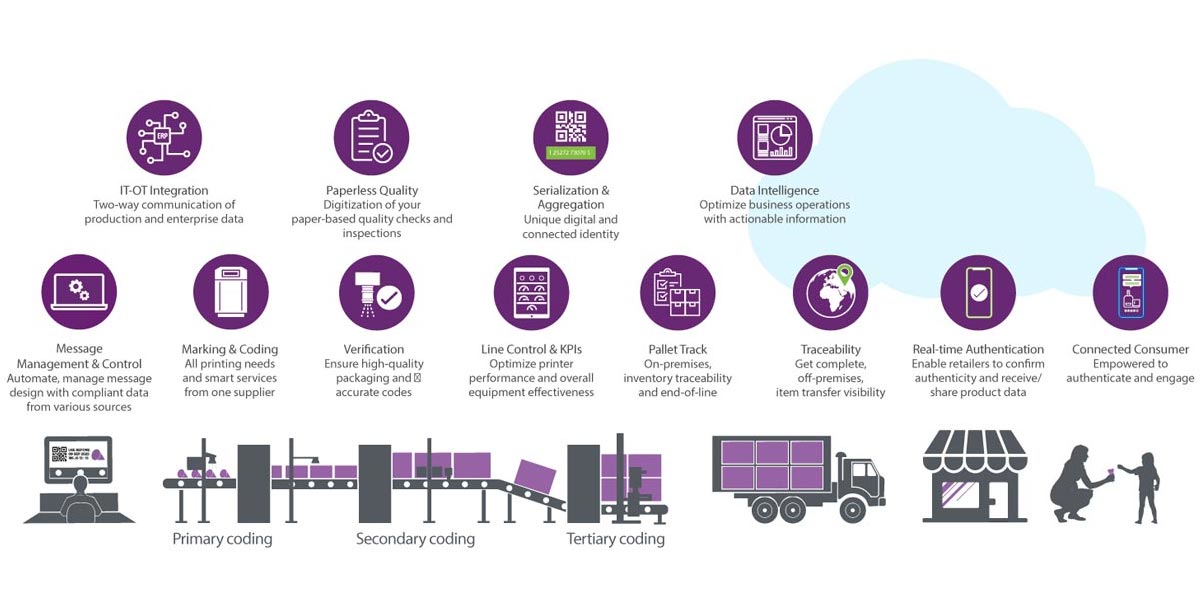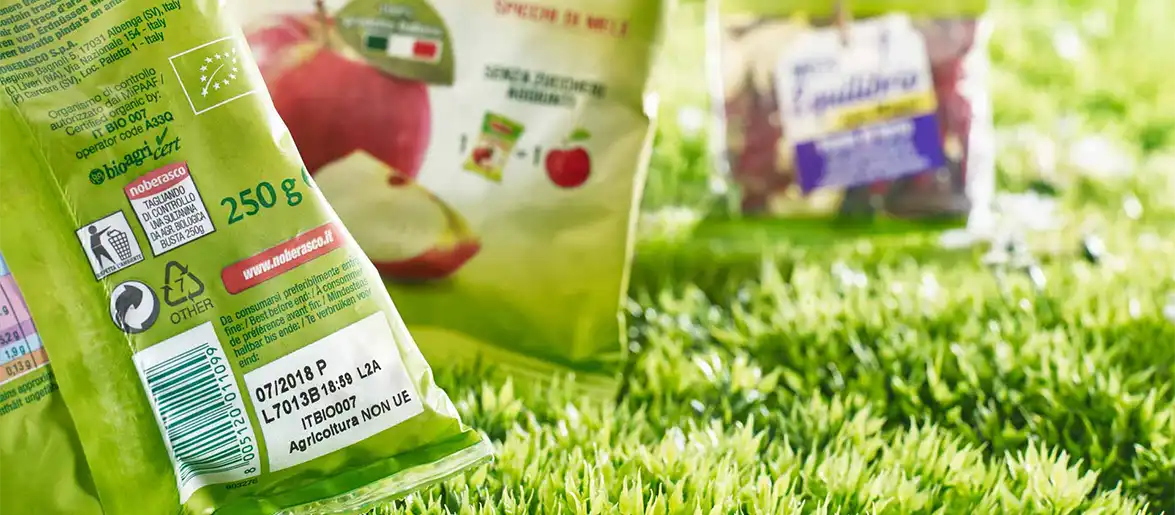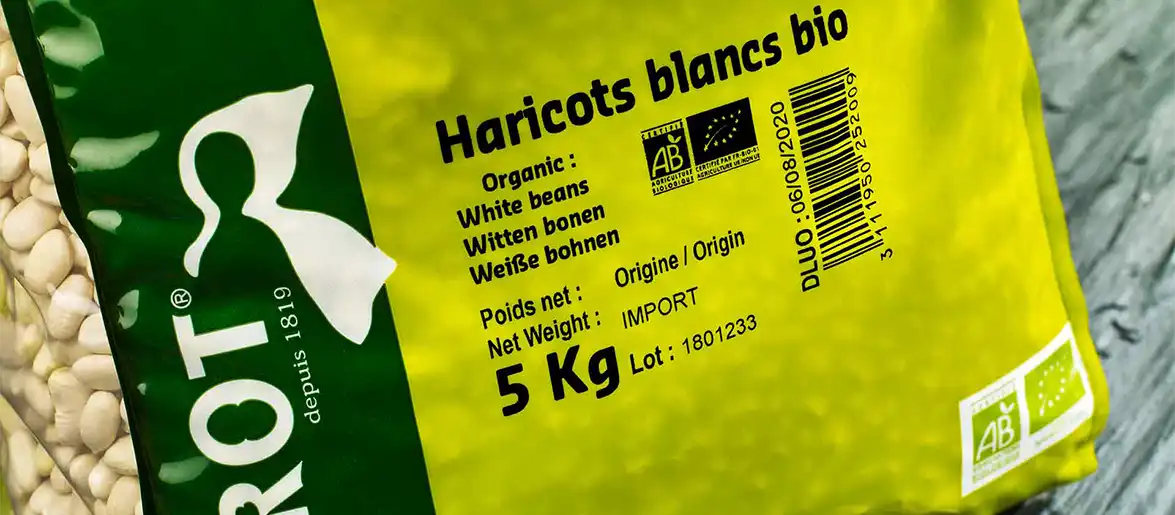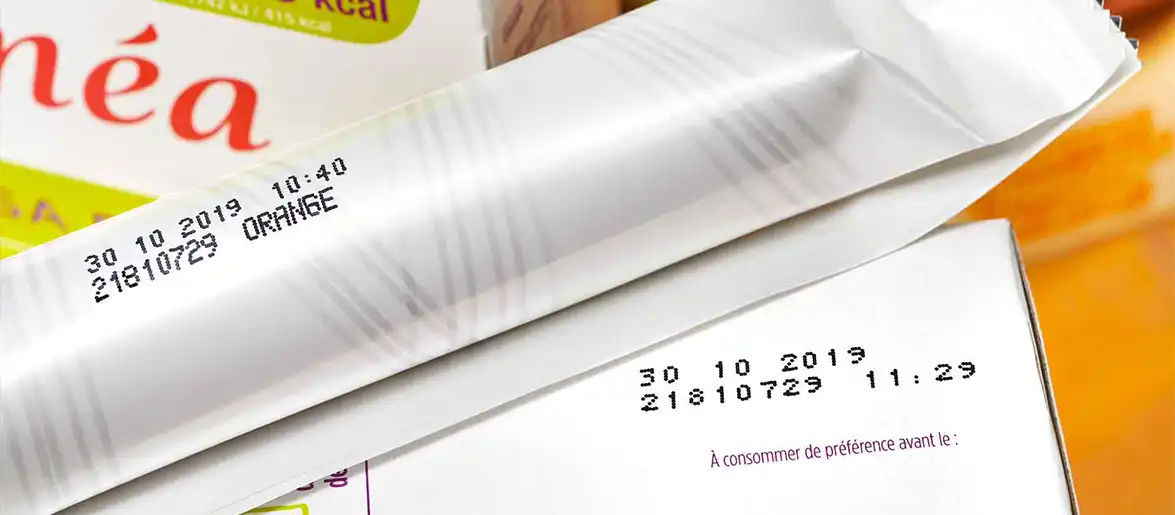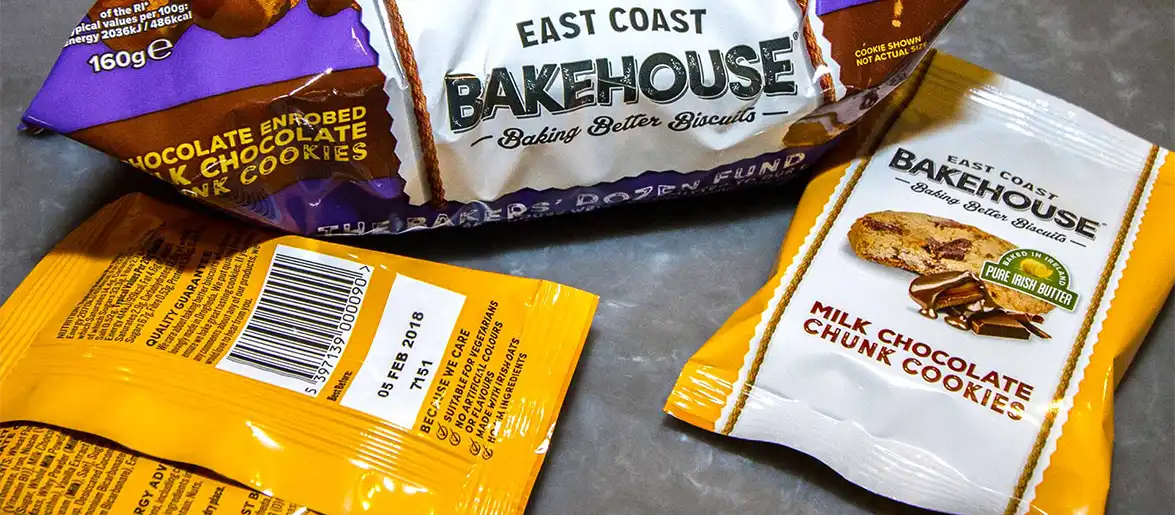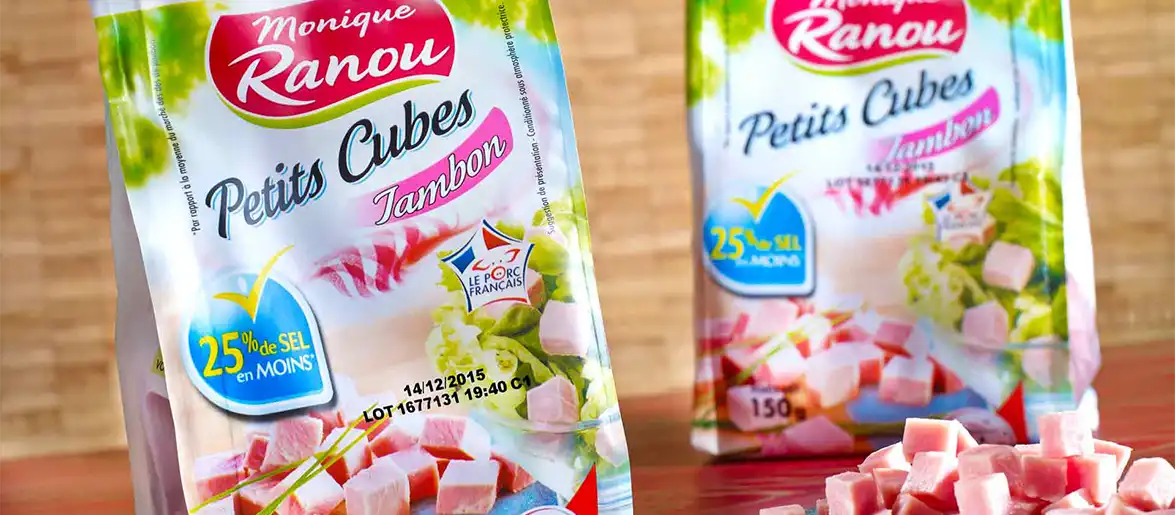Pouch printing machine offers
High-quality, 100% compliant coding solutions for all your flexible packaging or pouch printing requirements.

YOUR CHALLENGES
Pouch printing or flexible packaging printing, which includes film and foil formats from stand-up pouches to candy wrappers, is the most in-demand primary package application in food packaging today, especially for cookies, snacks, and confectionery. It is also among the most popular primary package applications across the FMCG sector. Flexible packaging printing is also popular throughout the industrial sector and in pharma but presents some general, critical challenges that not all coders can address. Failure to choose the optimal technology and the correct ink or adhesives in flexible packaging printing can result in errors and costly downtime. The requirements for a flexible packaging printer have become increasingly complex due to several reasons:
- An increasing need to include more information on the packaging e.g. for traceability, and to code in more complex formats, including in 2D, like QR codes.
- The requirement to code at higher production speeds and pack rates with a need to maintain consistently excellent quality.
- Demand for waste reduction and increased sustainability, meaning reducing film thickness to cut material use which can be challenging for coding.
- Increasing demand for biodegradable and recyclable films, including mono films, which can, also, present challenges for code quality.
- A wide range of substrates and composite materials are used in flexible packaging foils and films today with different properties and coding requirements.
Fortunately, we can help you find the ideal pouch printing machine to meet your needs.
OUR SOLUTIONS
Flexible films and foils are popular globally across the industrial sector, FMCG, and especially, the entire food production segment, from confectionary to dairy, because they are less costly and produce less waste than alternatives. Simultaneously, flexible films are also available in a wide range of materials with diverse properties. Flexible packaging printing is also less environmentally impactful, using light materials in small quantities to produce strong packaging, thereby requiring less energy than other alternatives. Moreover, there is a trend to move from multilayer composite materials toward more recyclable, thinner mono-material films. Markem-Imaje offers seven suitable coding technologies for flexible packaging printing: thermal transfer overprinting (TTO), continuous inkjet (CIJ), large character inkjet (LCIJ), thermal inkjet (TIJ), CO2, fiber, and UV laser.
When it comes to formats, the most popular varieties include stand-up pouches, often made of linear low-density polyethylene (LLDPE), which preserves the freshness of foods and liquids while allowing for more portioning size options. They are ideal for products designed for microwaving or cook-in-the-bag technology. Stand-up pouches also facilitate an appealing and effective package design by providing large surface areas upon which to print high-impact messages and visuals. Transparent windows within the pouch can also be used to showcase the product itself and increase its appeal to consumers.
Wrappers, like those used in confectionary, are made with different materials, such as a mix of plastic and aluminium, or paper and aluminium. With an ever-increasing demand for sustainability, wrappers are increasingly made of 100% aluminium foil which facilitates recyclability.
Besides the food industry, various flexible films are popular throughout industrial production: LLDPE is commonly used to make plastic bags, and cable covering, among others; while the recyclable film, BOPE, is also used for shopping bags and pharmaceutical goods.
It’s time to maximize recyclability in addition to your uptime and overall equipment effectiveness (OEE) with your choice of Markem-Imaje flexible packaging printer.
Please note, if you are looking for flexible shrink wrap film for primary, secondary or pallet printing, please visit our shrink wrap dedicated webpage.
Simply leave your e-mail address in the box to the right of this page to be contacted by one of our experts who can provide detailed information and can help you find the best solution for your pouch printing and flexible packaging printing needs.
What our customers say about our solutions
The topic of packaging is a perennial issue for us. There is a growing demand for better recyclability of packaging. We need strong partners who will work with us to drive innovation, to support us on how we can save more packaging material and use environmentally-friendly materials.
Christine Breyer, Marketing Manager at Töpfer.
We valued this solution as the cornerstone that would help develop our partnership.
Davide Cammi, Plant Director at Noberasco.
The SmartDate® OEM Connect, thanks to its compact design, can be installed directly into the machine. Together with it, we also installed a Mark & Read vision system, which makes it possible to check the code stamped on the package and thus be certain that the product is coded before being sent to the market, avoiding expensive reprocessing and reducing line waste with sustainable development.
Andrea Boccolini, VFFS Technical Sales Support Manager at IMA Ilapak.
Quick links — Jump to the right section directly!
Connected Packaging and Packaging Intelligence software
Our Packaging Intelligence solutions combine our proven coding and marking expertise with our experience to deliver complete turnkey solutions for achieving the maximum packaging line efficiency, trouble-free data management, and supply chain traceability all the way to the consumer’s hands. CoLOS® will significantly enhance your productivity and quality control while also addressing the challenges of waste and costs in an ever-changing manufacturing environment, creating a smarter business. Looking for a partner to develop your product’s digital roadmap? Markem-Imaje end-to-end solutions include leading solutions for supply chain traceability and authentication through our Systech brand and an ultimate consumer engagement experience with Blue Bite.
For more than three decades, Markem-Imaje has pioneered innovation in thermal transfer overprinting (TTO), a technology specially designed for flexible film packaging printing with our leading SmartDate® Series. With a typical output of 300 dpi, TTO offers very high print quality that blends in with the overall design of the pre-printed film.
Markem-Imaje SmartDate ® X30
TTO printer designed for low- to medium-speed production. The SmartDate ® X30 is a robust one-box solution that can easily be installed on your line or integrated by OEMs. With unmatched reliability, this is an ideal coder for flexible films.
View SmartDate X30Markem-Imaje SmartDate ® X45
TTO printer designed for easy integration into medium-duty equipment, the SmartDate ® X45 prints at up to 600 mm per second, allowing for 220 printed packs per minute at 300 dpi. It features a 10.1” color user interface that simplifies tracking OEE data.
View Smartdate X45Markem-Imaje SmartDate ® X65
TTO printer designed for direct integration into heavy-duty equipment and demanding applications, the SmartDate ® X65 is ideal for ultrafast, high-resolution flexible packaging printing at up to 455 printed packs or 1,800 mm per second. A unique ‘relative motion’ feature ensures that a code is completed after unplanned line stoppages, ensuring compliance and product traceability.
View Smartdate X65With more than four decades of experience in Continuous Inkjet (CIJ printer) innovation, Markem-Imaje has a full range of coders for flexible packaging printing. Our vast ink portfolio, including competitively priced MEK-free inks and reduced VOC varieties for reduced environmental impact, makes Markem-Imaje CIJ printers the most flexible and one of the most reliable on the market today. Designed for maximum uptime and ease-of-use, our CIJ range simplifies daily activities and makes your coding process seamless.
Markem-Imaje 9018
For quality and cost-effective basic printing suited to single-shift operations. This compact and easy-to-use coder guarantees high quality, non-stop production marking for up to 6,000 hours.
Markem-Imaje 9750
CIJ printer designed for medium to heavy-duty production lines, for digitalization and traceability with its unique 24-pin interface delivering clear, customizable, traceable black or colored codes, including 2D codes (QR and DotCodes), in a modular format which is easy-to-use.
Markem-Imaje 9750 Expert Series
CIJ printer designed for the most challenging FMCG coding operations, the market-first 9750 Expert Series of CIJ printers are fast and have been innovated to mark tiny surfaces, deliver enhanced 2D messages, including QR codes, and only require one type of coder for dye or pigment prints.
View Markem-Imaje 9750 Ew+Markem-Imaje 9330
CIJ printer designed for light to medium duty production lines, the 9330 series offers versatility, cost-effectiveness and longevity, covering all your basic coding needs, with the capacity to print for more than 8,000 hours non-stop.
View Markem-Imaje 9330 EMarkem-Imaje 9750 +
CIJ printer designed for medium to heavy-duty production lines, the 9750+ features a revolutionary, polyvalent ink circuit for both standard marking or pigmented contrast printing, giving you the highest level of flexibility and inventory streamlining across your installed base.
View Markem-Imaje 9750 E
CIJ Flexible Packaging Consumables
We offer a full range of proprietary inks to match your flexible packaging printing requirements, including MEK-free options. Our consumables range includes tape-resistant inks with a high level of resistance to water, cleaning agents and the pasteurization process, ideal for food packaging printing e.g. pouches. Also available, and dedicated to the confectionary sector, is a fast-drying MEK-free solution. A high-adhesion ink primed for monolayer and recyclable flexible plastics that improves performance and meets stringent compliance regulations is also available.
Markem-Imaje has decades of experience with our easy-to-integrate, operate, and maintain high resolution piezo Large Character Inkjet (LCIJ) printers and our non-hazardous, solvent free Touch Dry® hot melt ink that solidifies on contact and produces darker, high-quality codes. Our LCIJ printers with Touch Dry® ink are the ideal solutions for marking and coding, including GS1 compliant 1D and 2D barcodes and logos, all with lower TCO.
Markem-Imaje 5800
Offering a lower-cost solution and employing the same instantly solid Touch Dry® ink technology for medium throughput applications, the 5800 is equipped with unique printheads that use smaller ink blocks inserted directly into the printhead
and allow for the use of up to 4 different colors of ink on the same line.
Markem-Imaje 5940 G
Using Touch Dry® ink technology for consistently scannable 1D and 2D compliant barcodes with maximized uptime and great throughput thanks to its larger ink supply, the 5940 G is built to be reliable even in tough industrial environments and features Intelli’Flow® technology to keep printhead jets clear.
View Markem-Imaje 5940 GMarkem-Imaje Touch Dry® small character inkjet consumables
5016 Touch Dry® hot melt ink developed specifically for small character applications printing on flexible film. 5016 ink is highly resistant to rubbing and pick-off providing long lasting, high-quality codes running on high-speed, high-volume production lines.
The Markem-Imaje range of thermal inkjet (TIJ) printers offer high-quality compliant barcodes printed directly onto films, contact-free. They require little maintenance and excel on intermittent or low to mid-volume production lines.
Markem-Imaje 1050
Our 1050 thermal inkjet (TIJ) printer offers precision print control at exceptional value-for-money producing codes from 12.7 mm to 50.8 mm high, plus the ability to print readable 1D and 2D barcodes. The printer is low-maintenance with snap-in and snap-out cartridges.
View Markem-Imaje 1050Our SmartLase ® fiber, UV and CO2 laser printers provide high-quality, permanent codes for flexible film packaging applications. With patented Intelli’Arc® scribing, paired with on-board Intelli’Cool®, our lasers deliver crisp, high-contrast codes with greater uptime and reliability than others.
SmartLase ® C150 and C350
30-watt laser printer designed for medium to high-speed intermittent or continuous lines, the SmartLase ® C150 and C350 30-watt CO2 lasers deliver permanent, crisp, clear and traceable codes on flexible packaging, at up to 150,000 products per hour.
View SmartLase® C150 and C350SmartLase ® F250
Laser marker designed for high-speed applications, excelling on high-density plastic and metalized materials, the F250 20-watt fiber laser offers superb code quality, even with the increasing code complexity associated with 1D and 2D codes.
View SmartLase® F250SmartLase ® C600
Laser printer for high-speed extrusion coding, even with the increasing code complexity of 1D and 2D codes. The C600 delivers superb code quality and more power, all in an easy-to-integrate and easy-to-operate industrial grade unit.
View SmartLase® C600SmartLase® UV 500
Laser printer designed for high-speed on high-density materials including flexible films, our SmartLase® UV500 5-watt UV laser delivers the most precise, high-quality coding with the added benefit of minimal heat transfer.
View SmartLase® UV 5002D codes have already become an indispensable method of connecting your products to the Internet, facilitating vast amounts of product data and customization possibilities. They are also simultaneously becoming essential to comply with new regulations and standards, especially concerning traceability, including for the GS1 Digital Link, Digital Product Passport, and the US FDA’s FSMA regulations. The advantages of 2D codes for boosting brand loyalty through the supply chain are unrivaled. The possibilities for promoting sustainability efforts, packaging design efficiencies, and retail process optimization are enviable.
With the GS1 set to begin phasing out 1D barcodes in favor of 2D codes like the QR and DataMatrix from 2027, at Markem-Imaje, we have GS1 Digital Link-compliant 2D codes at the heart of our innovations from our coding hardware to software solutions supporting leading brands and retailers around the world to define and implement their connected product roadmap. Connect with us to talk to an expert or read more on our 2D solutions dedicated page!
Leave your e-mail address in the box to be contacted by one of our experts who can provide detailed information and can help you find the best solution for your flexible packaging printing needs.
You may also be interested in discovering more about...
Consumables and supplies
Find our genuine CIJ, DOD, TIJ, and Touch Dry Hot melt inks adapted to each marking need:
Inks and additives.
Find the thermal printing ribbon products:
Ribbons and labels.
Software
Find options to digitalize your packaging operations easily:
CoLOS software solutions.
Solutions
Find our Packaging Intelligence Solution to enhance and achieve traceability:
CoLOS traceability solutions.
Find industry hot topics that benefit from using 2D barcodes for connected products:
Connected and compliant 2D barcodes.
Find out our Packaging Verification solutions.


